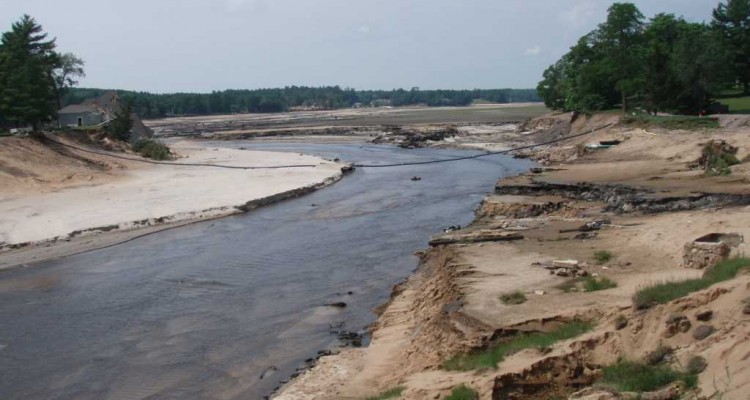
The Formation | The Draw | The Shift | The Future
The Future
On June 9, 2008, Tom Diehl from the Tommy Bartlett Show knew something big was about to happen. The rain had not let up for days, and by 2 a.m., the 12 inches of excess water needed to go somewhere. He gathered a group of 50 people in the early hours of the morning to start sandbagging the dam along Lake Delton, fearing it would break.
As he and the owner of the Wisconsin Ducks watched the rain fall and the water swell along the shoreline, he said, “In the next couple hours we’re not going to have a lake anymore.”
“There was nothing anyone could do about it,” Diehl says.
He knew the water would break through somewhere, at some point, but no one could predict that the rushing water would take a devastating detour and avoid the dam completely.
Like the creation of the sandstone cliffs, it was another chance of fate that ultimately caused one of the biggest environmental disasters Wisconsin has ever seen. No one knew that the ground beneath Highway A, along the north shore of Lake Delton, was filled 90 feet deep with weak sugar sand deposited there from the last ice age.
“No one would have known that,” Diehl says.
The rising water seeped into the ground, eroding the breach and gouging a 400-foot-wide channel into the road at 10 a.m., taking with it three houses and destroying any chance of business on the lake for that summer.
“Mentally, I am trying to figure out before this is happening is how we’re going to stay open without a lake, how are we going to keep the 150 people that we have employed to work for us this summer,” Diehl says. “Because this is June 9, how are we going to be able to live up to our commitments?”
The man-made lake, host of summer fun in Wisconsin Dells since the 1920s, could not hold up to nature. In a matter of two hours, Lake Delton’s seemingly endless water was gone.
[soundcloud url=”https://api.soundcloud.com/tracks/177984762″ params=”color=ff5500&auto_play=false&hide_related=false&show_comments=true&show_user=true&show_reposts=false” width=”100%” height=”166″ iframe=”true” /]
Tom Diehl, operator of the Tommy Bartlett show, explains the implications of the Lake Delton washout.
The Wisconsin Dells is a symbol of her state’s abundance of water. For centuries she’s quenched an ever-building thirst.
From the days when the Ho-Chunk fished in these waters, to the first rowboats that traversed the river, to the towering waterparks that now cover the landscape, humans’ obsession with and expectations of water have escalated incessantly.
Eager for the next upside down water slide, for the next hydroflight water rocket, for the faster jet boat tour, visitors’ standards are ever-increasing into expectations that force businesses to dig for the next fad.
Like decades past, resort and waterpark development will one day reach maturity, and the Dells will be forced to find a new niche.
“What I see in most ventures is they only have a limited time,” Feldt says. “This is only going to be popular for so many years, and something new will come along.”
Once it was the natural water, then transitioned to go-karts, arcades and Duck tours. For now, it’s waterparks. What will it be next?
Still, the thirst persists, as expectations reach the limit of the seemingly impossible. Just as the Ho-Chunk Casino attempts to bring the Wisconsin River and its glorious sandstone indoors, the Village of Lake Delton pushed a little too hard for paradise.
On July 12, 2012, 500 gallons of dye and $29,108 taxpayer dollars were dumped into Lake Delton — masking the algae-filled water with a cerulean blue.
While the village and company that facilitated the effort assured people that the dye was 100 percent safe, others are still skeptical. Alexandra Mucek remembers the event well.
“It wasn’t the Wisconsin Dells. Lake Delton water is brown. It’s drinkable, but it’s brown and they made it blue. That’s terrible,” Mucek says. “What’s natural is natural, and that wasn’t natural.”
But today, beyond the Wisconsin River, what is truly natural in the Dells?
The painted cement columns of Mt. Olympus, the plastic trees lining the Kalahari Waterparks and the demolished White House sitting along Highway 12, as if dropped roof-first into a parking lot, certainly are not.
Go to the Ho-Chunk Casino and you may feel that the fake sandstone and rushing water, pumped by an indoor fountain, have shown you everything the Dells has to offer. But step outside, away from the casino, from the bright pink waterslides, from the fake blue lake. Stand along the sandstone cliffs as the Wisconsin River rushes beneath you, feel the history of the water and these unique rocks that have been here for centuries — here lies the glory of the Dells.
“We never want to lose sight of the fact that anybody can build a man-made attraction anywhere,” Diehl says. “We cannot forget that you come for the beauty and you stay for the fun.”

